Teaching and building. Temporary Architecture between research and didactics
DOI:
https://doi.org/10.19229/2464-9309/432018Keywords:
temporary architecture, applied research, experimental teaching, shelters, experimental constructionsAbstract
The development of digital design technologies offers undoubted teaching tools for design and planning: project, pro-jectare, throwing forward. Parametric design, BIM, augmented reality are now present in vocabulary and professional skills, but they often create a detachment from reality and materiality. The architecture, the unique and real one, is the built one, in which the material and spatial essences demonstrate whether the theoretical assumptions are valid or not. Imagining educational paths that lead students to create real artefacts is an innovative, unusual approach that combines educational research with applied research. The article outlines a path of collaboration among various institutions and tracks the premises, methodologies, and results, proposing future research developments and offering opportunities for dissemination, replication and dissemination.
Downloads
Article Metrics Graph
References
Galilei, G. (1623), Il Saggiatore, Acrobat edizioni, Roma. [Online] available at: www.astrofilibresciani.it/Biblioteca_UAB/Biblioteca/Galileo-Saggiatore.pdf [Accessed October 2018].
Kobayashi, H. (2018), “Empathic Design using Agile Technology”, in Proceedings on International Conference on Smart, Sustainable and Sensuous Settlements Transformation (3SSettlements), Munich, Technical University of Munich, Munich. [Online] Available at: www.iaarc-academy.com [Accessed October 2018].
Kuma, K. (2015), Small Architecture / Natural Architecture, Architectural Association Publications, London.
Kuma, K. (2018), “Kengo Kuma: A Lab for Materials”, in JA, n. 109.
Laugier, M. A. (1753), Essai sur l’architecture, Getty Research Institute, Paris. [Online] Available at: archive.org/details/essaisurlarchite00laug/page/10 [Accessed 22 October 2018].
Masera, G., Imperadori, M., Vanossi, A., Liotta, S. J. and Ito, Y. (2015), “Modular, Adaptable Shelters for Environmentally Sensitive Archaeological Sites”, in, Falk, A., Vegh, P. and Chilton, J. (eds.), Proceedings of the IASS Working Groups 12 + 18 – International Colloquium 2015 Bio-based and Bio-inspired Environmentally Compatible Structures, Tokyo Denki University, Tokyo. [Online] Available at: hdl.handle.net/11311/962428 [Accessed October 2018].
Vanossi, A., Parello, G., Imperadori, M., Bennardo, C., Liotta, S. J. and Ito, Y. (2014), “BIM for archaeology, Use of BIM process and parametric model in a temporary shelter adaptable to the diverse needs of archaeological sites”, in Della Torre, S. and Borgarino, M. P. (eds), Proceedings of the International Conference Preventive and Planned Conservation 2014, Nardini Editore, Monza, Mantova.
Vanossi, A., Parello, G., Imperadori, M., Bennardo, C., Liotta, S. J., Ito, Y. and Occhipinti, F. (2015), “Architecture for Archeology: identifying new modular and flexible types of shelter adaptable to the diverse needs of archaeological sites”, in Gambardella, C. (ed.), Best practices in heritage conservation and management from the world to Pompeii, Atti del XII Forum Internazionale Le Vie dei Mercanti, La Scuola di Pitagora, Anversa-Capri. [Online] Available at: www.leviedeimercanti.it/wp-content/uploads/2015/11/Pagine-da-sintesi-Atti-XII-Forum.pdf [Accessed October 2018].
www.artesella.it [Accessed October 2018].
www.farmculturalpark.com [Accessed October 2018].
www.smartgeometry.org/sg2008-munich/ [Accessed October 2018].

Downloads
Published
How to Cite
Issue
Section
License
This Journal is published under Creative Commons Attribution Licence 4.0 (CC-BY).
License scheme | Legal code
This License allows anyone to:
Share: copy and redistribute the material in any medium or format.
Adapt: remix, transform, and build upon the material for any purpose, even commercially.
Under the following terms
Attribution: Users must give appropriate credit, provide a link to the license, and indicate if changes were made; users may do so in any reasonable manner, but not in any way that suggests the licensor endorses them or their use.
No additional restrictions: Users may not apply legal terms or technological measures that legally restrict others from doing anything the license permits.
Notices
Users do not have to comply with the license for elements of the material in the public domain or where your use is permitted by an applicable exception or limitation.
No warranties are given. The license may not give users all of the permissions necessary for their intended use. For example, other rights such as publicity, privacy, or moral rights may limit how you use the material.


















































































